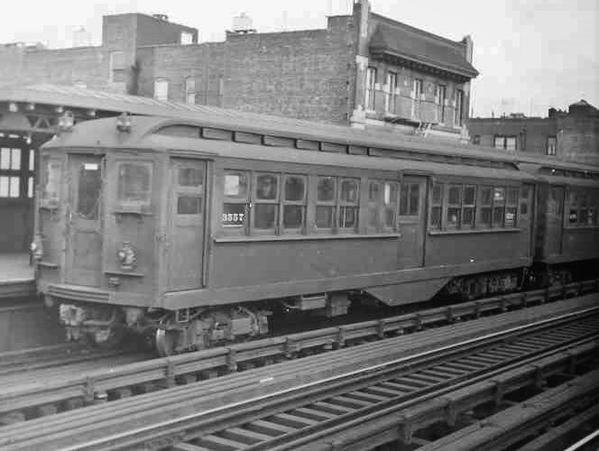| Re: [PHOTO] MOTORMAN (1479626) | |||
|
|
|||
| Home > SubChat | |||
|
[ Read Responses | Post a New Response | Return to the Index ] |
|
||
Re: [PHOTO] MOTORMAN |
|
|
Posted by JOE @ NYCMTS - NYCTMG on Thu Jun 28 20:07:57 2018, in response to Re: [PHOTO] MOTORMAN, posted by Express Rider on Thu Jun 28 18:57:20 2018. Hello Express Man and AllThe motorman is standing in the vestibule of an IRT GIBBS Car -- the Gibbs car had 180 degrees swinging end storm doors. When the, a, motorman was in the operating position on the front vestibule of a train's with the head end car being a GIBBS car, the storm door was shut flush with the outside end bulkhead. He could open the drop sash window seen in the image (like later R-21's late had) to get outside rush of air. With the door closed that way, it kept the cold and rain and snow out of the vestibule. He had the whole vestibule to himself...precursor of later full width cabs of today. BEHIND the motorman were two sliding "parlor type" doors that slid into pockets in the two separate inner bulkhead walls --see photo below of inside of a Gibbs car with the doors shown in closed position to close off the motorman position on the vestibule.  Each door glass had a roller shade (dark green as I recall, I rode these cars in the 1950's) which was lowered to keep the interior car car lighting from shining thru to his darkened cab. Better for forward glass vision in dark subway tunnels. On the ends of Gibbs cars that were NOT operating positions, that 180 degrees swinging end storm door, was swung 180 degrees inward to close in front of the inside of the motorman window and cover the cab controls, gauges, etc. Like the later folding cab doors on other IRT cars with folding cabs. Thus, the vestibule on these GIBBS cars when coupled to another car, was exposed to the outside elements -- rain, snow, cold, etc) THAT'S WHY the twin end inside bulkhead parlor doors existed, to close off the car INTERIOR and passengers from same. In summer times, the inside twin parlor doors would be in closed (slid into their pockets) position to let air rush thru the cars to alleviate the heat. Of course, in a big rain storm, perhaps the conductor closed the doors. Many Gibbs cars were converted to MUDC with new side doors in the vestibule -- and a new outside storm door that slid into a pocket - with the original storm door retained to cover the operating controls  I rode these (and deck Roofers) on head end of both IRT East Side Pelham Line and IRT West Side (IRT Broadway Line)in the 1950 thru 1958 periods when they were removed. HATED the Gibbs cars then because of the full width cab -- BUT REVERE THEM NOW FOR NOSTALGIA AND MEMORIES. Below are two photos of my fully scratch-built IRT GIBBS Car seen at the rear of a local train at an EL station on my "EL"...   Regards - Joe F |